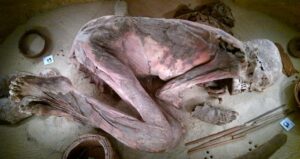The Gruesome Tale of the Laughing Death Epidemic

 The symptoms were gradual but inexorable. It began with headaches, joint pain and tremors in the hands and feet, mild at first but growing steadily in intensity. The victims’ movements became increasingly uncoordinated and clumsy, their stance and gait unsteady. Soon they were unable to walk at all, racked by severe tremors and muscle spasms. And then came the most alarming symptoms of all, as victims began bursting into tears or uncontrollable laughter without provocation. Confusion, delirium, and paralysis followed, until they were unable to move, speak, eat, or make eye contact. Finally, 12 months after the onset of symptoms, came the inevitable arrival of death. This was Kuru, a terrifying and incurable neurodegenerative disease that for nearly 100 years terrorized the Fore [“four-ay”] people of Papua New Guinea. For more than half a century the origins of Kuru remained a mystery, until in the 1960s groundbreaking research revealed it to be caused not by a bacterium, virus, parasite, or even a fungus, but something far stranger.
The symptoms were gradual but inexorable. It began with headaches, joint pain and tremors in the hands and feet, mild at first but growing steadily in intensity. The victims’ movements became increasingly uncoordinated and clumsy, their stance and gait unsteady. Soon they were unable to walk at all, racked by severe tremors and muscle spasms. And then came the most alarming symptoms of all, as victims began bursting into tears or uncontrollable laughter without provocation. Confusion, delirium, and paralysis followed, until they were unable to move, speak, eat, or make eye contact. Finally, 12 months after the onset of symptoms, came the inevitable arrival of death. This was Kuru, a terrifying and incurable neurodegenerative disease that for nearly 100 years terrorized the Fore [“four-ay”] people of Papua New Guinea. For more than half a century the origins of Kuru remained a mystery, until in the 1960s groundbreaking research revealed it to be caused not by a bacterium, virus, parasite, or even a fungus, but something far stranger.
In 1914, in the early stages of the First World War, the Australian army invaded and occupied the Imperial German colony of New Guinea. What eventually became known as Papua New Guinea would remain under Australian control for another 70 years, and over the following decades missionaries and Colonial Patrol Officers or “Kiaps” penetrated deeper and deeper into the interior in an attempt to bring christianity and western legal, administrative, and medical practices to the indigenous peoples of the island. In the early 1950s, reports began filtering back from Colonial officials of a strange and incurable disease plaguing the indigenous people of the Eastern Highlands, including the Fore and neighbouring Awa, Yate [“yatt-ay”], and Usurfa. Known to the Fore as kuru, from the word kuria meaning “to shake” or “to tremble,” the disease caused a progressive loss of muscular control and invariably death. Kuru was also known as “nagi-nagi” or “laughing sickness” after the tendency of victims to burst into spontaneous laughter in the latter stages of the disease. Thought to have originated sometime in the early 1900s, by the 1950s Kuru had grown into a full-blown epidemic, killing around 200 Fore – or 1% of the population – every year.
The first westerner to describe Kuru was Colonial patrol officer Arthur Carey, who observed in a 1951 report that the disease disproportionately affected Fore women and children over the men. The disease was also described by anthropologists Ronald and Catherine Berndt in 1952 and patrol officer John McArthur in 1953. However, all dismissed the epidemic as a purely psychosomatic phenomenon, a form of mass hysteria deriving from Fore beliefs in witchcraft and spirit possession. Indeed, the Fore themselves initially believed that Kuru to be caused by malicious sorcerers from rival groups, who would acquire parts of the victim’s body such as hair or nail clippings and combined with clothing, leaves, blood and other materials to form a “kuru bundle.” The sorcerer would then shake the bundle daily until the telltale tremors of kuru were induced in the intended victim.
However, American virologist Daniel Gajdusek and physician Vincent Zigas strongly doubted that Kuru could be purely psychological, writing to Ronald Berndt that:
“…our current opinion [is] that fatal kuru cannot by any stretch of the imagination be identified with hysteria, psychoses or any known psychologically induced illnesses. The evidence for direct nervous system damage is far too great in the strabismus [drooping or crossed eyes], and pictures of advanced neurological disease shown by the advanced cases.”
Consequently, in 1957 Gajdusek and Zigas launched the first proper scientific study of Kuru. Their analysis, published in the Medical Journal of Australia, suggested that Kuru might be genetic in origin, passed down along family lines. However, confirmation of this hypothesis would require closer study of kinship among the Fore. So in 1961, medical researcher Michael Alpers and anthropologist Shirley Lindenbaum, using a research grant from the Rockefeller Foundation, travelled to the Eastern Highlands of Papua New Guinea to conduct a thorough anthropological and epidemiological study of the Fore.
Over the next two years, Alpers and Lindenbaum discovered that kinship among the Fore was not strictly based on biological relatedness, but rather a complex system of social association and bonding with neighbouring individuals. Kuru, they found, spread mainly along kinship lines and not strictly between biologically-related individuals, making it unlikely that it was transmitted genetically. Epidemiological data further ruled out transmission by air, insects, or contaminated water. So, just how was it transmitted? The unexpected answer would stun the scientific community and open a strange new chapter in the study of human disease: Kuru, Alpers and Lindenbaum discovered, was spread through cannibalism.
At the time, the Fore People practiced a form of what is known as mortuary cannibalism, ritually consuming the bodies of deceased family members as a means of honouring the dead and returning their spirit or “life force” to the community. Bodies would be buried for several days until they were infested with maggots before being exhumed and dismembered, cooked, and eaten communally, the maggots being served as a side dish. And while the Fore avoided the bodies of those who had died of dysentery, leprosy, and other diseases, those who succumbed to Kuru were still regularly consumed.
The more Alpers and Lindenbaum observed, the more convinced they became that this practice was at the heart of the Kuru epidemic. For example, preparation of the bodies was performed almost exclusively by women, who were also far more likely to engage in cannibalism than men. There were two main reasons for this: first, Male Fore believed that eating human flesh would weaken them in times of war. Second, women’s bodies were thought to be better able to tame the absorbed spirits of the dead. More telling still, the brain – the organ most affected by Kuru – was also largely consumed by women and children, while men, when they did engage in cannibalism, preferred to eat the bodies of other men. Together, these facts seemed to explain why Kuru affected predominantly women and children, with only around 3% of Fore men succumbing to the disease.
Yet despite this compelling evidence for Kuru’s origins and transmission route, scientists still did not know what actually caused the disease. In order to find out, in 1968 Alpers collected brain sample tissues from the body of an 11-year-old Fore girl who had died of Kuru and delivered them to Daniel Gajdusek at the National Institutes of Health. Along with collaborator Joe Gibbs, Gajdusek ground up the samples and injected them into the brains of chimpanzees. Within two years the apes began showing the telltale signs of kuru: severe tremors, gradual loss of muscular control and cognitive function, and finally death. When Gajdusek and Gibbs autopsied the animal, they found that its brain – particularly the cerebellum, which controls muscular coordination – was riddled with millions of microscopic holes, giving it the appearance of a sponge or Swiss cheese under the microscope. This experiment not only confirmed that Kuru was spread via infected tissue and that it directly attacked the brain, but was also an extremely rare instance of a disease jumping from one species to another in a laboratory setting and the first known case of a contagious neurodegenerative disorder. But while this research would earn Gajdusek the Nobel Prize in Physiology and Medicine in 1976, he was ultimately unable to isolate the actual pathogen responsible for Kuru. Experiment after experiment ruled out bacteria, viruses, fungi, and protists, leaving the actual causative agent a baffling mystery.
The mystery of Kuru would not be solved until the late 1970s, when Gajdusek, along with British researchers E.J. Field, Tikvah Alper, and John Griffith, noted striking similarities between Kuru and the ailments scrapie and Creutzfeldt-Jakob [“kroyts-felt yah-cob”] disease or CYD. Scrapie, first described in the 18th Century, is a disease affecting mainly sheep and goats, named for the itching sensation that causes afflicted animals to scrape their skin raw on trees and fences; while CYD is a rare human neurodegenerative disorder first described in the 1920s. Like Kuru, both are untreatable and invariably fatal. In a series of groundbreaking experiments, Griffith demonstrated that scrapie could be transmitted via infected brain tissue which had been completely sterilized, and that the causative agent, whatever it was, was resistant to destruction by heating, ultraviolet light, and ionizing radiation. This lead Griffith to a radical conclusion: that these diseases were caused not by conventional pathogens, but something far stranger: rogue misshapen proteins called prions.
Unlike bacteria, protists, fungi or – depending on which side of a particularly heated scientific debate you happen to stand – viruses, prions – a contraction of proteinaceous infectious particles – are not actually alive. Rather they are proteins, of the same types that make up the bodies of healthy humans and animals. However, prions are the Mr. Hyde to the original protein’s Dr. Jekyll, a misshapen, deformed variant incapable of performing its original biological function. When a prion enters the body, it latches on to another, normal version of the same protein, causing it to transform into the same mutated form as itself. This in turn triggers a deadly chain reaction, gradually transforming and destroying the entirety of the host tissue. Though prion diseases are typically acquired from other infected hosts, they can occur spontaneously when normal proteins mutate into a malignant form, triggering the same transformational chain reaction. Indeed, it is now believed that Kuru in New Guinea originated sometime in the early 1900s when an unknown individual spontaneously developed the disease, and gradually spread through the Fore population via mortuary cannibalism.
The sponge-like holes the prions inflict in the victim’s brain tissue are what give Kuru, CYD, scrapie, and similar diseases their collective name: transmissible spongiform encephalopathy. If that name sounds familiar, it might be because prions are also responsible for bovine spongiform encephalopathy or BSE, better known as “Mad Cow Disease.” Like Kuru, BSE is also spread through cannibalism, though of a rather different sort. In the 1980s and 1990s, a massive outbreak of BSE in the UK was linked to the use of Meat-and-Bone Meal or MBM in animal feed. MBM is rendered from the parts of slaughtered animals considered unfit for human consumption, including blood, bone, hooves, horn, skin, and – most relevant to the transmission of BSE – brain and nerve tissue. The transmission of BSE via infected animal feed devastated the UK livestock sector, triggering worldwide bans on British beef, killing hundreds of cows outright, and resulting in four million animals being slaughtered and incinerated in an attempt to contain the outbreak. Even more tragically, 177 people contracted Variant Creutzfeldt-Jakob Disease, the human form of BSE, from eating contaminated beef, with all invariably succumbing to the disease. In the wake of the outbreak, the UK banned the use of MBM for the feeding cows, sheep, goats, and other ruminant animals, though it remains a common ingredient in pet food.
Though their existence had been theorized for over a decade, prions were not isolated in the laboratory until 1982 by American researcher Stanley Prusiner of the University of California, earning him the 1997 Nobel Prize in Physiology and Medicine. This discovery of a brand-new infectious agent opened up a brand-new field in the study of communicable diseases, and lead geneticists to rethink certain assumptions regarding the transmission of structural information between genes and proteins. Some scientists now also suspect that Alzheimer’s disease may also be caused by a type of prion, opening exciting new avenues of research for the treatment of this disease, which afflicts up to 30 million people worldwide every year.
Yet despite this new understanding, mysteries still surrounded Kuru, the first human prion disease to be positively identified. Even before cannibalism was suspected as the cause of Kuru, the practice was strongly discouraged by missionaries and Colonial patrol officers. By the 1960s, when Alpers and Lindenbaum began their groundbreaking study, the Fore had all but abandoned mortuary cannibalism. However, the epidemic continued for decades, with deaths between 1987 and 1995 averaging 7 per year. It is now known that Kuru has an extremely long latency period, ranging anywhere from 3 to 50 years between infection and the onset of symptoms, allowing cases to appear long after the abandonment of cannibalism. Indeed, the fact that nobody born after 1960 has ever contracted the disease has served to confirm the link between Kuru and the practice of mortuary cannibalism.
Thankfully, however, there is reason to believe that after more than 100 years, the Kuru epidemic may at last be over. The last person died of Kuru 2009, and no new cases have been reported as of 2010. Even more encouragingly, it appears as though Fore may actually have developed immunity to Kuru, shielding them from future outbreaks. A 1996 study conducted by a team from University College London found a high prevalence of a gene mutation called G127 among the Fore, which prevents malignant prions like Kuru from infecting the brain. Genetic analysis has further revealed that this mutation appeared as recently as 10 generations ago. As John Collinge, a researcher at University College’s Prion Unit remarked:
“It’s absolutely fascinating to see Darwinian principles at work here. This community of people has developed their own biologically unique response to a truly terrible epidemic. The fact that this genetic evolution has happened in a matter of decades is remarkable.”
So for all you aspiring Hannibal Lecters out there, the tragic case of Kuru provides yet one more reason why – outside of extreme survival situations – cannibalism is rarely a good idea. Better to pair your fava beans and chianti with something slightly less exotic.
If you liked this article, you might also enjoy our new popular podcast, The BrainFood Show (iTunes, Spotify, Google Play Music, Feed), as well as:
- Are Viruses Actually Alive?
- The Man Who Parkinson’s Disease is Named After Was Implicated in a Plot to Assassinate King George III
- Why Do People Seem To Get More Colds In The Winter?
- Why Toenails Turn Yellow
Expand for References
Alpers, Michael, The Epidemiology of Kuru in the Period 1987 to 1995, Australian Government Department of Health, December 31, 2005, https://www1.health.gov.au/internet/main/publishing.nsf/content/cda-cdi2904i.htm
Weiler. Nicholas, Alzheimer’s Disease is a ‘Double-Prion Disorder’, Study Shows, University of California San Fransisco, May 1, 2019, https://www.ucsf.edu/news/2019/05/414326/alzheimers-disease-double-prion-disorder-study-shows
Stanley B. Prusiner – Facts, The Nobel Prize for Physiology and Medicine 1997, https://www.nobelprize.org/prizes/medicine/1997/prusiner/facts/
Press Release: Baruch S. Blumberg and D. Carleton Gajdusek, Karolinska Institutet, October 14, 1976, https://www.nobelprize.org/prizes/medicine/1976/press-release/
Kelleher, Colm, Brain Trust: the Hidden Connection Between Mad Cow and Misdiagnosed Alzheimer’s Disease, Paraview Piocket Books, New York, 2004, https://books.google.ca/books?id=AGAhAtI3kJEC&q=Gajdusek+drill+holes&pg=PA53&redir_esc=y#v=onepage&q=Gajdusek%20drill%20holes&f=false
Lindenbaum, Shirley, An Annotated History of Kuru, April 14, 2015, http://journals.ed.ac.uk/index.php/mat/article/download/4590/6242?inline=1
Kompoliti, K & Ferguson-Smith, M, Kuru (Disease), ScienceDirect, https://www.sciencedirect.com/topics/medicine-and-dentistry/kuru-disease
Liberski, Pawel et al, Kuru, the First Human Prion Disease, Viruses, March 2019, https://www.ncbi.nlm.nih.gov/pmc/articles/PMC6466359/
Brain Disease ‘Resistance Gene” Evolves in Papua New Guinea Community; Could Offer Insights into CJD, Science Daily, November 21, 2009, https://www.sciencedaily.com/releases/2009/11/091120091959.htm
Liberski, P & Brown, P, Kuru: Its Ramifications After Fifty Years, Experimental Gerontology, 2008, https://hal.archives-ouvertes.fr/hal-00499057/file/PEER_stage2_10.1016%252Fj.exger.2008.05.010.pdf
Bichell, Rae, When People Ate People, a Strange Disease Emerged, NPR, September 6, 2016, https://www.npr.org/sections/thesalt/2016/09/06/482952588/when-people-ate-people-a-strange-disease-emerged
Rudan, Igor, The Laughing Death, https://irudan.medium.com/the-laughing-death-edba313c6791
Lagnado, John, From Pabulum to Prions (via DNA): a Tale of Two Griffiths, Past Times, https://watermark.silverchair.com/bio027040033.pdf?token=AQECAHi208BE49Ooan9kkhW_Ercy7Dm3ZL_9Cf3qfKAc485ysgAAA7QwggOwBgkqhkiG9w0BBwagggOhMIIDnQIBADCCA5YGCSqGSIb3DQEHATAeBglghkgBZQMEAS4wEQQMwkM3d3WfqalCT8mrAgEQgIIDZyN0GxVQWVs2v35f4jxJwFv7BfSvjiClhMtSExpRUasvyH2yusXOayzQLZpM25GFVm0AnSjL3R45f96N67lJCmCBLvVjaPXDBJjMIoK7QTmb1w1Uji5M0NuVUY_bjTRxXEEoB09cE0x9iGQ1YpJIM-wIbTOKg-1KD7gJ16kPd2dQkMNL7fit58HF0Mj9LxkHgzDKAFAtLhj_AaUoNAs9uGsz6Gs4LWNizRpDUw47lPHRFfut7BDdpBMKZx6sqPEMT2bN9wNY3SBreJm3BjJ-jGspKNNbkHBbx1xKYmbnml1exB6tma90VPZtueWZHbbmiYLaAdCZax6zp-4XZRzz0JLMLzS44mwu9djL47_Ak-mWWo5lYVJUInsmbi29uHVKi7YGQDUh0ePZKitnzECwIWi-F-MGXJJ4tDn5iAUdGc7ATkxyIC6S0rS4Se6dbg4jXD0kaMkrMuzix1C1FCpVxqBUKzAYZuZrc06PYzPZiPzdM5cLGKpdM4MCF7F_vixUnQ37He_l-bdg1QveVTLvsdRpSrBdHkbuIGek2UR5sJsqF51hNk5qeix3ZW21EOEOLk14IPsvtzJen-K_W7VL4Nduzt-f3YpxMN0MoBlM1nyV924v6jbfvfN8KqSDBWurA8op2LjHNmno-gFobR4slO82rQVi1y0z6yCcV3J7VDO5JE9ldPFD_msHLJjF8RaZ9thgYSJZzWHYY_xLF4OIcdhyhSxVGRtPHdYeiPVNxbUyMo8lRPolzHhqBFEgd004JTHCpzY9-0fBniXcl_FJHcGXtCjrtd1kp2AySKdWr64T3FwefX9b_BHnKTjGXnS1uRTifh9nKs99q6k-5-_k0A-TIWxpK52VEw3wJBB3GInWROihbOL4p-je-KOcNFt9dR3vD1m6cHzGJP77bIF2yWjgqJAQMAG0asog4NBSPYrRRnrrEMroQNmuhtkJMmkCP7vDxzlIgaW4HLnfqV1aA0G7CM8OPaq3sST9YA_uH6e1F3441NHrTspc8Nd1ewfyrEtIIEHZ0Ffz0hHeN2mgxWygyLzWzH2r0G4bbuzwCVab0yxCP7UKhWhA_FsZch850DwOCetpTqeD2Pb-dlN5ftSH3bM64s9Q2vRZJAgxRUMUasRyE4yXwYi8UfPfdcL7xIxj6ftmquw
The post The Gruesome Tale of the Laughing Death Epidemic appeared first on Today I Found Out.












